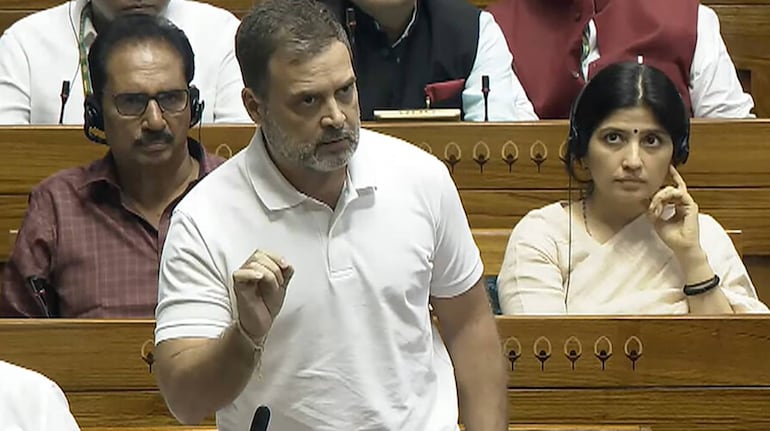



Rahul Gandhi’s recent speeches in Parliament have been noteworthy more for its semiotics than for their content, per se. What has attracted most attention has been his use of terms, symbols and episodes from the Hindu tradition to criticize the self-styled party of Hindutva, the BJP -- not just its policies and conduct as the ruling party, but its core, ascriptive identity as the champion of the country’s allegedly victimized majority.
In the process, the Congress leader also seeks to demolish the BJP’s characterization of the Congress as the party of Muslims and of state pandering to Muslims.
Political sense in the approach…It makes eminent political sense for the Congress to deny the BJP the monopoly it has been constructing on all things Hindu. It is also necessary for the Congress to break out of the confines of its negative characterisation by the BJP, as the party of minority appeasement.
But remember your ideological rootsIn the process, the Congress should not forget to assert its role as the foremost proponent and defender of the non-denominational ideal of Indian citizenship, attacked by the proponents of Hindutva as amounting to betrayal of India’s Hindu glory of yore.
That means defending the Nehruvian ‘Idea of India’, against sectarian nationalism of the majoritarian kind, on the one hand, and, on the other, against non-Hindu communities’ attempt to preserve custom and tradition incompatible with democracy in the name of religious freedom and secularism.
Rahul Gandhi used the notion of the Abhaya Mudra – the outward-facing open palm bequeathing peace and content, associated with gods of Hinduism, the Buddha, Jainism and Guru Nanak – to decry the BJP’s use of the state’s agencies of coercion to instil fear in the hearts of the party’s opponents. He called upon the BJP to be neither scared nor to try to scare others.
Post-budget performanceIn his discussion of the Budget, the Leader of the Opposition did not spend any time discussing matters fiscal, but used the occasion for political criticism of the ruling party. He described the Budget as the chakravyuha, a battle formation that traps enemy soldiers within its concentric circles and does not allow them to escape. He described the supposed victims of the Budget, the middle class, the unemployed, small industry, etc, as being trapped.
In the Mahabharat, the chakravyuha is symbolic of both impregnable menace and vile deceit.
Drona, who succeeds Bhishma as commander of the Kaurava army forms this battle formation to lure Abhimanyu, the 16-year-old son of Arjuna and deadly warrior, into the battle formation. Arjuna had been lured by an army to fight away from the site of the chakravyuha.
The story goes that Arjuna had described how to penetrate the maze-like chakravyuha to his wife Subhadra, who was then pregnant with a son. The son, named Abhimanyu, later heard and absorbed the lesson in the womb. Unfortunately, Arjuna had to leave his wife’s side, before he could narrate how to get out of the battle formation. So, Abhimanyu was born with the knowledge of how to get into the war maze, but not of how to get out.
When Drona challenged the Pandavas with his chakravyuha, Arjuna was away and only Abhimanyu, of those who were left to accept the challenge, knew how to penetrate the deployment. It was agreed that other Pandava warriors would follow Abhimanyu into the maze, once he showed them the way. But after Abhimanyu went in, those who tried to follow him were blocked by Jayadratha, who had secured a boon that he would be able, just for one day, to stop the Pandavas, save Arjuna. The lone young warrior was surrounded by a host of Kaurava commanders, attacked without any concession to the rules of fair battle, and finally killed by Dusshasana’s son.
Follow | Parliament Session LIVE UpdateThe chakravyuha thus emerges as the symbol of entrapment and merciless assault by the powerful on valour and innocence.
Political image makeoverBy using the metaphor of the chakravyuha to describe the Budget, Rahul Gandhi was able to evoke the sense of unfair oppression in relation to the Budget proposals. At the same time, he was able to present himself as someone at home with the cultural idiom most Indians are familiar with. Gandhi then went on to say that the BJP’s Hindutva is like the chakravyuha, while genuine Hinduism is like Shiva’s baraat, a happy procession that anyone is free to join and be a part of. The use of Hindu iconography to criticise sectarian exclusion as non-Hindu is effective.
What lies beyond rhetoric?So far, so good. But use of mythology commonly understood across the subcontinent to communicate certain ideas should not lead to uncritical espousal of the ideological underpinning of the mythology, or of a perception of such uncritical ideological espousal. For, caste and rigid social hierarchy are part of that ideological underpinning, and Gandhi has been trying to present himself as a fighter against caste injustice.
The point, ultimately, is to create a political discourse that makes democracy and its enrichment the focal point of political mobilisation, so that rejection of majoritarian politics and of minority appeasement meld seamlessly into that discourse.
Discover the latest Business News, Sensex, and Nifty updates. Obtain Personal Finance insights, tax queries, and expert opinions on Moneycontrol or download the Moneycontrol App to stay updated!
Find the best of Al News in one place, specially curated for you every weekend.
Stay on top of the latest tech trends and biggest startup news.